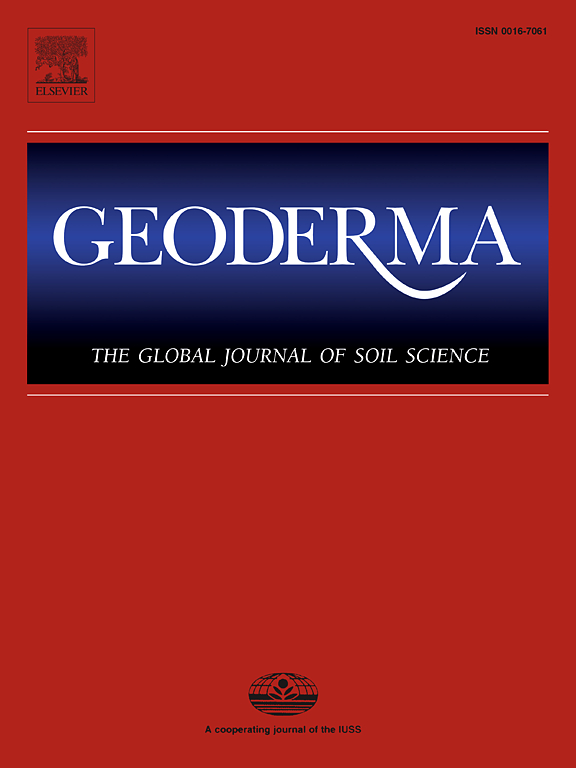Variations and controlling factors of soil CO2 release at daytime and nighttime scales in the loess hilly regions of China
IF 5.6
1区 农林科学
Q1 SOIL SCIENCE
引用次数: 0
Abstract
Soil carbon dioxide (CO2) release is a critical ecosystem process affecting regional and global carbon cycles. Currently, one of the key uncertainties in projecting carbon-climate feedback is the ongoing poor representation of the deep and nighttime soil CO2 release. Using CO2 probes at hourly intervals in the Robinia. pseudoacacia plantation in the loess hilly regions of China, this study explored the relationship of soil respiration between daytime and nighttime and the discrepancy in the influence of climate, vegetation, and soil properties on soil respiration at the 0–10, 10–50, and 50–100 cm soil depth. We estimated that the cumulative CO2 release at 0–100 cm soil depth reached 688.6 g·m−2·year−1, including a 29.1 % relative contribution from the 10–100 cm soil depths. This outcome showed the necessity for accurate quantification of deep soil CO2 release. We also revealed that the cumulative CO2 release was similar between daytime and nighttime throughout four seasons at the 0–100 cm soil depths. This result demonstrated that soil CO2 release can be predicted based on daytime measurements. Soil temperature < 0℃ was not identified as a primary driver, which only explained 1 %–4% of the variation in soil respiration. Meanwhile, the temperature sensitivity of soil respiration decreased by 1.3–1.8 times when soil temperatures were < 0°C compared to when soil temperatures were > 0°C. Thus, using the correlation model based on soil temperature to predict soil respiration might introduce slight inaccuracies in outcomes when soil temperatures are < 0°C. Soil respiration is intimately associated with soil temperature, soil organic carbon content, root biomass, and leaf carbon content; the cumulative contributions of climate, vegetation, and soil properties to soil respiration were 12 %–18 %, 18 %–30 %, and 41 %–50 % during daytime and 12 %–25 % 24 %–28 %, and 40 %–46 % during nighttime at soil depths of 0–10, 10–50, 50–100 cm. Additionally, Structural Equation Modelling implied that soil moisture and temperature directly affected soil respiration during the daytime, and air temperature and relative humidity acted as indirect factors during the nighttime. Clarifying the cumulative soil CO2 release relationship between the daytime and nighttime could help predict the soil C cycle with high precision within various climates in forest ecosystems.
中国黄土丘陵区昼夜尺度土壤CO2释放变化及控制因素
土壤二氧化碳(CO2)释放是影响区域和全球碳循环的关键生态系统过程。目前,预测碳-气候反馈的关键不确定性之一是对深层和夜间土壤二氧化碳释放的持续不足。在Robinia每隔一小时使用二氧化碳探测器。以黄土丘陵区刺槐人工林为研究对象,研究了0 ~ 10、10 ~ 50、50 ~ 100 cm土壤深度的昼夜土壤呼吸关系,以及气候、植被和土壤性质对土壤呼吸的影响差异。我们估计,0 ~ 100 cm土壤深度的累积CO2释放量达到688.6 g·m−2·年−1,其中10 ~ 100 cm土壤深度的相对贡献为29.1%。这一结果表明了对深层土壤CO2释放进行精确量化的必要性。我们还发现,在0-100 cm土壤深度,4个季节的昼夜累积CO2释放量相似。这一结果表明,土壤CO2释放可以基于白天的测量来预测。土壤温度<;0℃未被确定为主要驱动因素,仅解释了土壤呼吸变化的1% -4%。与此同时,当土壤温度为1℃时,土壤呼吸的温度敏感性降低1.3 ~ 1.8倍;与土壤温度为>;0°C。因此,使用基于土壤温度的相关模型来预测土壤呼吸,当土壤温度为<时,结果可能会有轻微的不准确性;0°C。土壤呼吸与土壤温度、土壤有机碳含量、根系生物量和叶片碳含量密切相关;在0 ~ 10、10 ~ 50、50 ~ 100 cm土层,气候、植被和土壤性质对土壤呼吸的累积贡献在白天分别为12% ~ 18%、18% ~ 30%和41% ~ 50%,在夜间分别为12% ~ 25%、24% ~ 28%和40% ~ 46%。此外,结构方程模型表明,土壤湿度和温度在白天直接影响土壤呼吸,而气温和相对湿度在夜间间接影响土壤呼吸。明确昼夜累积土壤CO2释放关系,有助于对森林生态系统不同气候条件下土壤C循环进行高精度预测。
本文章由计算机程序翻译,如有差异,请以英文原文为准。
求助全文
约1分钟内获得全文
求助全文
来源期刊

Geoderma
农林科学-土壤科学
CiteScore
11.80
自引率
6.60%
发文量
597
审稿时长
58 days
期刊介绍:
Geoderma - the global journal of soil science - welcomes authors, readers and soil research from all parts of the world, encourages worldwide soil studies, and embraces all aspects of soil science and its associated pedagogy. The journal particularly welcomes interdisciplinary work focusing on dynamic soil processes and functions across space and time.
 求助内容:
求助内容: 应助结果提醒方式:
应助结果提醒方式:


